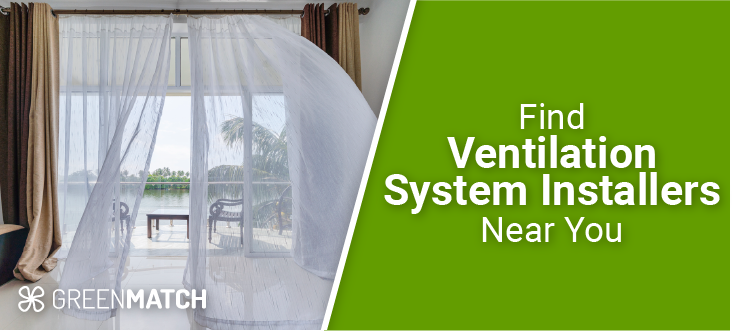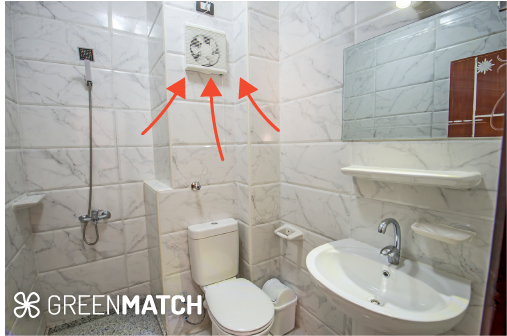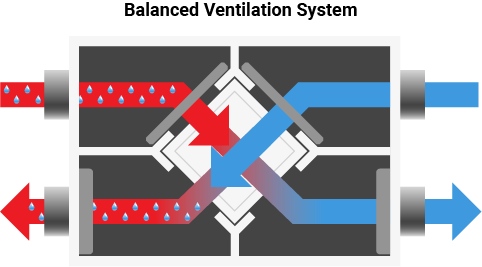You will be redirected to a Leads.io registration page.

Get up to 3 quotes from our selected suppliers by filling in only 1 form

Save money by comparing quotes and choosing the most competitive offer

Our service is 100% free and with no obligation
- GreenMatch.com
- HVAC
- Ventilation
Ventilation: Natural & Mechanical Ventilation Types
What ventilation is the right choice for your home?

Ventilation is the process of circulating the air in your home to maintain a healthy indoor environment. It works by exchanging indoor and outdoor air, removing pollutants, excess moisture, and odors, leaving behind fresh air for you and your family to breathe in. Proper ventilation not only improves indoor air quality but also reduces the risk of airborne illnesses, ensuring your and your family’s overall health and well-being.
There are two main types of ventilation: natural ventilation and mechanical ventilation. In the olden times, natural ventilation was the most popular and the only method of ventilation for homeowners. This type of ventilation basically involves natural movement of air through open doors and windows along with other avenues such as cracks in walls, gaps around doors and windows, basements, or crawl spaces.
With the changing building codes and regulations, homes became more airtight, making natural ventilation difficult. Moreover, extreme weather conditions also make natural ventilation difficult. This called for the introduction of mechanical ventilation, which uses fans and ducts for the exchange of indoor and outdoor air. Mechanical ventilation systems are better at controlling the flow of pollutants, odors, and moisture into your home. It is more uniform compared to natural ventilation, which is more of an uncontrolled flow of air into and out of your home.
There are two main types of mechanical ventilation systems that you can install in your home. These are spot ventilation and whole home ventilation systems. Spot ventilation, as the name suggests, is used for a particular spot in your home, like the kitchen or bathroom. Whole home ventilation systems are those that are used to ventilate your entire home all at once. There are exhaust-only, supply-only, and balanced ventilation systems that are used for whole home ventilation.
Choosing the right ventilation is just as important as finding the right installer. When trying to find an HVAC contractor who best fits your requirements you spend hours of your time. You call one installer after the other, explain your requirements and require quotes to compare. At GreenMatch, we will match up to 3 installers who would be the best fit for you. Simply click on the button below and we will get you up to three quotes for you to compare. Our service is free with no obligation.
Fill in the form in just 1 minute
Why is Ventilation Important for Your Home?
Home ventilation is very important for you and your family to be able to breathe in fresh air all the time. Ventilation, at its basic, is an exchange of stale air for fresh air in your home. The homes built under the current building code and regulations are more airtight compared to older homes. Air could easily circulate into and from
your home through open doors, windows, cracks in walls, etc. and exchanged stale air for fresh air. However, airtight homes make the circulation of air, or in other words natural ventilation difficult. This means that the IAQ is poor, leading you and your family to breathe in the stale air with pollutants all the time. This can in turn lead to health problems such as allergies, respiratory problems, and even headaches.
The airtight space also restricts the depletion of moisture from your home, which can indirectly promote the growth of mold and mildew. This can again trigger allergies and health conditions such as asthma. Moreover, proper ventilation ensures you enjoy moderate and balanced temperatures in your home. It also helps improve the overall energy efficiency of your home. Hence, in order to live a healthy, comfortable life with better indoor air quality, ventilation is very important.
Types of ventilation: Natural and Mechanical Ventilation
In the US, natural and mechanical ventilation are generally used in conjunction to maintain indoor air quality (IAQ). Natural ventilation is ideal for use in moderate weather conditions where extreme cold, winds, or heat are less of a bother when windows or doors are left open. Mechanical ventilation is often used as a supplement to natural ventilation. Otherwise, mechanical ventilation is ideal for use during extreme weather conditions, when leaving windows and doors would prove impractical.
Natural ventilation

Natural ventilation is a passive system dependent on wind, buoyancy, and temperature differences for air circulation. It exchanges stale air for fresh air through open windows, doors, and other avenues such as vents, cracks in the wall, etc. Natural ventilation helps maintain good indoor air quality through circulation of fresh air in your home. There are two main types of natural ventilation: wind-driven ventilation and stack ventilation.
Wind-driven ventilation is air flowing into your home from one side and exiting from the opposite side. This is a simple flow of air that goes through open doors and windows.
Stack ventilation allows hot air to rise and escape through the vents, at the same time allowing cool air to enter through the openings at the bottom of your house. This type of ventilation works on the natural buoyancy effect, where warm air rises creating a pressure difference and drawing in cooler air from below.
Natural ventilation is a low-energy, low-cost option that not only improves indoor air quality but also provides you with thermal comfort by regulating temperature and humidity levels. However, it is quite an unpredictable source of ventilation since it is dependent on weather conditions. It also limits your control over airflow, which at times may prove to be an inconvenience. Leaving the windows and doors open also leaves you and your family vulnerable to security issues, not to mention increased noise pollution.
Mechanical Ventilation
Mechanical ventilation is a ventilation system that uses mechanical equipment such as fans, blowers, and ducts to circulate air in your home. It is more common in residential buildings than homes, where natural ventilation may not be a practical option or insufficient for maintaining good IAQ. Mechanical ventilation can be either central (whole home ventilation) or local (spot ventilation), depending on your ventilation requirements.
With mechanical ventilation, you can experience consistent ventilation regardless of the weather conditions. You will also be able to exert greater control over the airflow throughout your home. Mechanical ventilation certainly offers improved energy efficiency and indoor air quality. However, these ventilation systems may cause you to incur high energy, maintenance, and installation costs. You’re heavily reliant on the equipment used for ventilation which may pose a problem in case it malfunctions or breaks down.
Spot ventilation:

Spot ventilation is a system focused on a specific area of your home, such as a bathroom, kitchen or even your laundry room. It works by removing pollutants and moisture from these areas with the use of local exhaust fans or ventilation hoods. Spot ventilation helps improve the indoor air quality of your home and in reducing the build-up of humidity, in turn, reducing the risk of mold or mildew growth.
Compared to whole home ventilation systems, spot ventilation can be more energy efficient as they are restricted to a specific area of your home. Although, this can also be a limitation as your spot ventilation would not work for all the areas of your home. These systems can also be noisy, especially if not installed properly or due to lack of maintenance. Additionally, you may incur increased maintenance and installation costs as they require additional equipment.
If you’re not sure whether your home requires spot ventilation or whole home ventilation, a professional installer can always be consulted for guidance. Finding an installer that best fits your budget and requirements is, however, a different challenge altogether. It takes up hours of your time, calling them one by one, explaining your requirements and requesting quotes. GreenMatch can do this for you and get you up to three installers’ quotes to compare. All you have to do is click on the button below. Our service is free with no obligation.
Fill in the form in just 1 minute
Whole home ventilation (Mechanical ventilation)
Whole home ventilation is a type of central ventilation system, where it uses mechanical equipment to ventilate your entire home at the same time. Being an active ventilation system, it consistently ventilates your home regardless of weather conditions. Unlike a natural ventilation system dependent on opening of doors and windows, which may be impractical in certain weather conditions. There are three main types of whole home ventilation systems: exhaust-only, supply-only, and balanced ventilation.
Exhaust-only ventilation

Exhaust-only ventilation uses a single exhaust fan to remove stale air from your home and allow fresh air to flow in through natural ventilation. This ventilation system is generally installed in homes where natural ventilation is insufficient or an impractical option. The exhaust fan is usually installed in your attic or the roof space of your building, which is then connected to ducts for drawing air from your home. The fan expels the air, allowing air to flow in through the open doors, windows, vents, etc.
It is a cost-effective and easy installation that not only reduces indoor pollutants and stale air but also aids the flow of natural, fresh air into your home. However, at the same time, the natural, fresh air is quite inconsistent and is widely dependent on external weather conditions, making it unsuitable for all climates. It may also increase energy consumption, leading to high energy costs.
Supply-only ventilation

Supply-only is a ventilation system that uses a single supply fan that wafts in fresh air and exhausts stale air through natural ventilation. This type of ventilation system is generally seen in newer or renovated homes where natural ventilation may seem insufficient or impractical. The fan, like with the exhaust-only ventilation, is generally installed in your attic or roof space of the building. It is then connected to ducts for drawing in fresh air from the outside and distributing it inside your home.
Supply-only ventilation offers consistent ventilation which improves the IAQ and provides a natural airflow for moderate temperatures in your home. It is also highly energy efficient but if not installed properly can cause an increase in energy bills. It also leaves you to have limited control over the flow of air and humidity levels in your home as it is dependent on natural ventilation for the removal of stale air. And for the same reason, it also may not be suitable for all climates, as leaving doors and windows open may become impractical.
Balanced Ventilation

A balanced ventilation system provides both supply and exhaust ventilation at equal rates throughout your home. It maintains a balanced airflow by bringing in the same amount of fresh air as is being exhausted into and from your home. A balanced system uses two fans, one for supply and one for exhaust, along with a network of ducts through which air circulates throughout your home. Homes that are tightly sealed and well-insulated, and where natural ventilation is insufficient or impractical would benefit the highest from a balanced ventilation system.
There are two types of balanced whole home ventilation systems:
Heat Recovery Ventilation (HRV) incorporates a heat exchanger that retains heat from the outgoing stale air and transfers it to the incoming fresh air. HRV systems are more commonly used in colder climates where indoor heating is required. These systems also improve indoor air quality and reduce the risk of mold and moisture buildup.
Energy Recovery Ventilation (ERV) incorporates a heat exchanger that retains both heat and moisture from the outgoing stale air and transfers it to the incoming fresh air. ERV systems are more commonly used in hot and humid climates where indoor cooling is required.
Balanced ventilation systems offer consistent ventilation through balanced airflows, is energy efficient and improves indoor air quality. However, it may also increase energy consumption and costs if not installed properly, which is why you may have to opt for professional installation. Furthermore, this type of ventilation may not be suitable for all climates, as it may be unable to maintain comfortable indoor temperatures and air quality due to poor installation.
Get the best ventilation system quotes

Comparing quotes is an important part of the process of finding the right HVAC installer. Each installer has different features to offer, making it necessary for you to compare quotes as a homeowner. Cost often varies from installer to installer, making it necessary to see what each is offering. Services and schemes may also differ from installer to installer. You would have to call each installer and figure out what they are offering, and at what cost.
However, sitting down for hours, calling installer after installer, and requesting quotes is quite a tiring and tedious task. We can simplify this process to a mere click. All you are required to do is fill in the form, and share your requirements, and we will match up to three installers for you to compare quotes. Our service is free with no obligations.
Fill in the form in just 1 minute
Frequently Asked Questions
There are two main types of ventilation, natural and mechanical ventilation. Most homes in the US use both, with mechanical ventilation often serving as a supplemental ventilation system. Each of these systems has its own pros and cons and uses dependent on different factors. It would be best to consult a professional installer to guide you through the process.
Natural ventilation and mechanical ventilation are the two main ventilation systems used in the US. Spot ventilation and whole home ventilation are two different types of mechanical ventilation.
Ideally, it would be best if you aired out your home every 15 to 20 minutes to improve indoor air quality. If you’re unable to use natural ventilation effectively, mechanical ventilation can always be used as a supplement to ventilate your home better.
We strive to connect our customers with the right product and supplier. Would you like to be part of GreenMatch?

